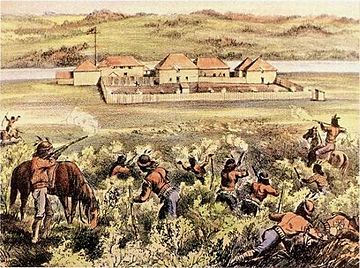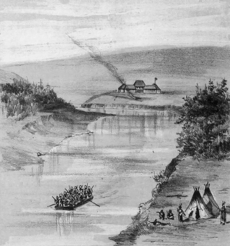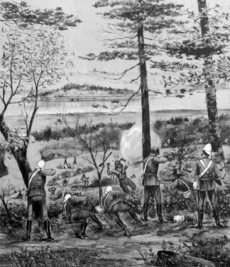North-West Mounted Police during the North-West Rebellion facts for kids

The North-West Mounted Police (NWMP) played an important part in the North-West Rebellion in Canada in 1885. The NWMP faced challenges early on. Even though they helped the main army led by Major-General Frederick Dobson Middleton, some people criticized their actions. Because of this, Commissioner Acheson Irvine later stepped down from his leadership role.
Contents
How the Rebellion Started
The rebellion began in the North Saskatchewan River valley in March 1885. It was led by the Métis people, with Louis Riel as their leader. The Métis had concerns about their land and rights. Riel wanted to form a new government and hoped the Cree people would join him. He planned to defeat the NWMP and then make the Canadian government negotiate with them.
The NWMP had known about rising tensions since the previous fall. They had increased their presence in the area over the winter. As things got more tense, Commissioner Acheson Irvine gathered more police officers in Regina. The fighting started when Riel's men took control of Batoche on March 18. They cut telegraph lines and took some people hostage.
Early Retreats and Challenges
At the start of the conflict, the NWMP had 562 officers. They quickly left most of their small posts along the valley. Fort Carlton seemed impossible to defend, so the police left it on March 27. They arrived at Prince Albert the next day. There, 225 police officers helped many people who were fleeing the fighting.
Instead of leaving Prince Albert, Commissioner Irvine decided to use it as a safe place for refugees. However, the town became cut off by the rebels.
On March 29, the rebel Cree approached Battleford. This town was protected by 43 NWMP officers led by Inspector William Morris. The town was looted, and the Cree surrounded the police fort for a while. At Fort Saskatchewan, near Edmonton, Inspector Arthur Griesbach worked to improve the defenses with his 20 NWMP officers. He also encouraged the town of Edmonton to do the same.
Inspector Francis Dickens was in charge of Fort Pitt with 25 men and limited ammunition. He made civilians special police officers. But he believed the fort could not be defended. He prepared to leave by boat. On April 13, Big Bear, with 250 Cree warriors, arrived and demanded they surrender. After talking and a confrontation, the civilians gave up. Dickens and his men escaped the fort using a makeshift boat. They were taken in by the police at Battleford on April 22.
Turning the Tide: Recovery Efforts
More than 5,000 soldiers from the Canadian militia quickly traveled west. They used the Canadian Pacific Railway. Major-General Frederick Middleton led these forces. Middleton's plan involved three groups attacking the rebel areas. Middleton himself led the main force to recapture Batoche.
The second and third groups were led by Lieutenant Colonel W. Otter and Major-General Thomas Strange. They were joined by 74 and 20 NWMP officers, respectively. The third group even had a large field gun.
Otter's men reached Battleford on May 1, 1885. They then marched south to Cut Knife Creek. They expected to find Poundmaker there. The NWMP formed the front of Otter's group. Otter surprised the camp at dawn. But the attack by the front troops quickly slowed down. Even though the Cree had limited weapons, the government forces were defeated. They had to retreat back to Battleford.
After some delays, Middleton finally attacked Batoche. He captured Riel there. Then, on May 20, he officially relieved Prince Albert. Strange's group advanced to Edmonton. Sam Steele of the NWMP led his scouts. They chased Big Bear and the remaining rebellious Cree until they were captured. Riel was held by the NWMP in Regina. He was tried, and this helped bring the rebellion to an end.
After the Rebellion
Major-General Middleton criticized the NWMP and Commissioner Irvine. He felt they stayed in Prince Albert too much during the campaign. He also thought they did not help him enough during the Battle of Batoche. Middleton even compared the NWMP to "gophers," saying they hid during fights. The newspapers picked up on these complaints.
Commissioner Irvine defended his decision to stay in Prince Albert. However, the press criticized him for not being "vigorous" enough. Without the support of the Prime Minister, he resigned the next year.
Some early historians defended the NWMP's actions. They said the police were mostly under the command of the army and General Middleton. They argued the police did not get many chances to show their bravery in battle. Later historians have been more critical. Some believe Irvine's failure to help Middleton was due to too much caution or not knowing what was happening. Others blame the police's performance on the government not supporting them enough. They also point to weak leadership from Commissioner Irvine before the rebellion.
However, historians generally agree that the NWMP's good relationships with local First Nation groups were very helpful during the campaign.



